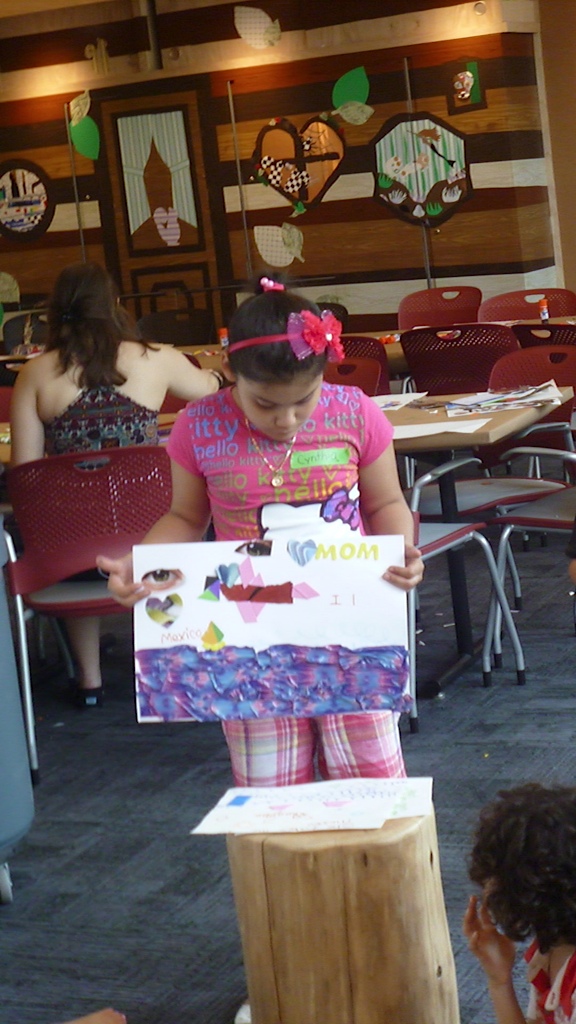
According to Einstein, "not everything that counts can be counted." Teaching children how to look at the world with a designer's eye definitely counts at Cooper-Hewitt, National Design Museum's new educational space located in Park Heights / Harlem neighborhood of New York City.
Recently, I had first-hand experience with the amazing staff as we presented two workshops inspired by the current exhibition on graphic design. The program was titled "Creative Communications." Participants, accompanied by parents, ranged in age from 2 to 9 years old. The project was to create a layout for a mini-billboard announcing why they love that someone special in their life. Each one -- including the youngest -- rose to the challenge!
Teaching design thinking to children is fun. Watching them let go of their fear is truly gratifying -- they thrive on taking risks. It is our job, as educators, to help them realize that learning by doing is a mindset applicable to any of their pursuits. Let me explain the steps involved by using Cooper-Hewitt's "Creative Communication" workshop as an example.
1: Envision new possibilities by striking a balance between familiar and fresh.
At first, while the topic is introduced, confusion and uncertainty prevail. To break the ice, I ask questions. Starting with the obvious, I swiftly move to thought-provoking: "What is a billboard? What makes it stand out? How can someone express something that is really important to him or her in a catchy way, succinctly and clearly, so that the message is understood instantly?" They are intrigued.
2: Study a situation in depth by engaging all senses, paying attention, keeping an open mind.
We brainstorm and mind map -- the ideas begin to flow. "I love my mom, because she makes me feel better when I am hurt." "She cooks my favorite food." "My mom rocks." "My dad plays with me -- we make pizza together." "My parents make sure I can do the things I am passionate about." They are warming up.
3: Face the unknown by cultivating the love of mystery.
It's time to engage with individual mind maps. They put their thoughts on paper, continue to formulate ideas. They get more and more enthusiastic, more comfortable with going ahead without knowing the outcome in advance. They are diving in.

4: Make unexpected connections by "thinking through making."
Next step is to zero in on one of the themes from the mind map and to propose a layout. So, Cynthia takes a phrase "she takes me places" and turns it into a story about flying to Mexico with her mom. The sketch she produces relates the experience succinctly and vividly. Jasper narrows it down to one favorite thing which is "nine-spotting ladybugs." He tells me how thrilling it really is. Eli condenses his list of "passions" and focuses on ballet, algebra, and gymnastics. They are addressing challenges.
5: Prioritize by making choices.
Yes! There is a method to this madness. We are moving right along. It's time to consider the issues of legibility and composition. After all, people reading the billboard will be driving and will only have approximately six or seven seconds to view and take in the message. How can they make their images stand out is the question. Turns out that there are lots of ways! A bold border, a graphically strong single image, popping out three-dimensional elements, etc. These are all good solutions. They are inventing.
6: Think across boundaries by solving a problem in a variety of ways.
All sorts of supplies are at hand: duct tape with designs on it, pencils, markers, alphabet stamps, stencils, magazines for collaging, colorful construction paper, and stickers help stir up imagination. Eli finds a scent strip (a companion to a fragrance ad), and decides to attract attention with smell. Clever, isn't it? Two friends sitting next to each other modify the edges of their mini billboards. They are creating.
7: Embrace ambiguity by allowing for success to arrive in stages.
Caitlin is here with both of her parents; they come to every program. In fact, I remember her from my previous Toying with Transformation workshop. Both mom and dad get very involved. Interestingly, her billboard is dedicated to Grandpa. I sense that it is important to interfere and set her free by contradicting her parents. She quickly takes off in her own direction. She is trusting her own instincts.
8: Share insights in a collaborative manner by unfolding and opening up while enjoying the process.
Presenting ideas to the group is all about getting feedback and getting new inspiration. Shy kids struggle, but do get out in front of the audience. Everyone cheers them on. We even get to hear two sisters perform a song that was incorporated in one of their designs! They are receiving feedback.

9: Make an impact by distilling lessons learned to what is relevant to you.
They walk away believing in themselves and their innate abilities. They have just been acknowledged. Good for them. They are proud of their accomplishments.
10: Care deeply by looking at the world with a fresh eye, appreciating and valuing what is around you.
I bet they will start paying attention to billboards from now on and evaluate them as if they were graphic designers. I bet they will use what they've learned to express their own point of view!
